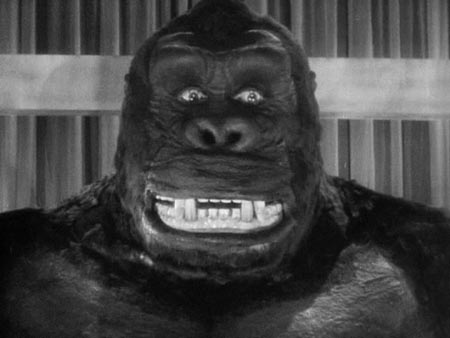In class, we had a short debate on whether prosthetics or computer generated imagery (cgi) stirred more thrills. After thinking about this after class, I found that I could not come to a decision. Prosthetics are tangible, and subsequently realistic if done properly. CGI is intangible, and while at times may seem less realistic, the technology is constantly improving, with almost possibilities only limited by a person’s imagination.
Prior to the turn of the century, the use of prosthetics was the norm, with CGI seeming like a gimmick. It is during this time that I think prosthetics had the clear advantage in terms of generating the thrills in movie goers, which we referred to in class. To use a science fiction film as an example, I would consider the original Star Wars series to be an example of prosthetics being superior to CGI. Using early technology, George Lucas superimposed various characters into the classic film. Below is a comparison of a physical v. digital Jabba the Hutt. Rather than the character appearing realistic, it seemed cartoony and laughable. Though the original film had relied on antiquated models and prosthetics, they had had a classic feel that was damaged with these digital additions.


CGI techniques have greatly improved since the early days. Now they are taken much more seriously, almost taking the classic “magic of the movies” out of the equation and moving it all to the computer. We see constant remakes of classic films, where directors reimagine the movies using CGI. The King Kong classic that we discussed briefly in class is one such example. Peter Jackson was able to take a claymation King Kong and transform him into a realistic CG-animated beast. This allowed for contemporary audiences to see King Kong in a shockingly realistic light, which was perhaps the same historically contextual experience that audiences had back in 1933. I feel CGI added a lot to the film, giving the movie its long lost thrills.


Tying back into the discussion on fear and anxiety, I feel that both CGI and prosthetics have their advantages and disadvantages. Right now, horror films use a combination of the two techniques in order to pull off frighteningly realistic effects. The remake of Nightmare on Elm Street uses a combination of effects to show a more realistic and gruesome depiction of Freddy Krueger. The dream sequences are able to tap into CGI technology to pull off astonishingly realistic effects that had not been available back in 1984. The audio is also digitally enhanced, bringing a supernatural quality to the character’s voice.


Finally, I believe the thrills are not generated by CGI or prosthetics in film, but rather in how they are implemented. I think it’s important to note that the remake of the “Nightmare on Elm Street” film had been rated 33/100 by Metacritic. Entertainment Weekly remarked positively on the films use of CG in crafting the character. “The new Freddy, his singed skin more icky-realistic and less latexy than before, has been molded to Haley’s already scary features: the sunken cheeks and pitted face, the mouth that leers like an open wound,” stated reviewer Owen Gleiberman. The New York Times review had a very different opinion of the CG in the film stating that, “The filmmakers’ use of computer-generated effects doesn’t help much, and makes a few of the scenes that should be horrifying look silly.” I suppose the final decision of prosthetics v. CGI is ultimately up to the movie goers.
Good post Jahn, I was thinking about our class discussion on CGI when I watched the Nostalgia Critic’s new video, “Old vs. New: King Kong,” here: http://thatguywiththeglasses.com/videolinks/thatguywiththeglasses/nostalgia-critic/20850-old-vs-new-king-kong. At 8:55, the Critic goes into a comparison of the effects of the 2005 Kong and 1933 Kong films, and at 10:59 he sorta references the effects of both movies in comparing their Kongs.
What do you think of his comment that the CGI in the newer King Kong isn’t really spectacular (note his examples of “good” CGI)? Are the effects of King Kong only there to help advance the story, and not to create a sort of “movies = magic” effect in the audience?
I’d love to hear what you think of his assertion that 1933 King Kong is more realistic than the newer Kong in the way he was depicted. Remember, the newer Kong is modeled after a human, but the older Kong, the Critic says, is more animal-like in his movements and expressions.
I feel that prosthetics definitely beat cgi when it comes to horror movies. I feel that cgi takes away from the horror of the film and makes you immediately feel the film is not real, prohibiting you from getting into it. I feel this can be for two reasons: the cgi is really bad and makes the viewer laugh at it, or the cgi creates an image that is so farfetched and would never appear in real life, once again prohibiting the viewer from getting into the movie. In the film High Tension and the Hills Have Eyes (remake), which are both done by the same director; the gore was done with prosthetics and made it all look very real. In the Hills Have Eyes there was actually a few scenes of cgi, one part with fire and another to slightly distort someone’s appearance. I feel these were done so subtly that the viewer would not even know it was cgi, which I feel still allowed the viewer to get into the movie.
I feel that CGI should only be used when recreating something with prosthetics would be impossible (King Kong, for example). With all the advancements in make-up and prosthetics, I feel that it should be used more often. Andrew makes a great point that using prosthetics makes everything feel more realistic. If you look at the 2010 Freddy Kruger, the prosthetics on him look so realistic and I don’t think the same effect would have been captured on CGI.